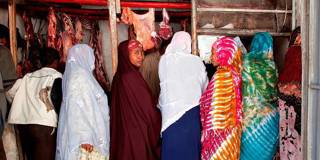During the last century, the battle to secure equality for women and girls has been fought in the classroom, in the voting booth, and in the boardrooms of Fortune 500 companies. But ending gender inequality will also require a commitment to tackling one of its root causes: malnutrition.
COPENHAGEN – During the last century, the battle to secure equality for women and girls has been fought in the classroom, in the voting booth, and in the boardrooms of Fortune 500 companies. But if gender inequality is ever to be abolished, we can no longer afford to neglect one of its major causes and consequences: malnutrition.
Right now, a staggering 1.6 billion people worldwide suffer from anemia, a condition strongly connected to iron deficiency – and one of the symptoms of a global nutrition crisis that disproportionally affects women. Indeed, anemia afflicts twice as many women as men – nearly one in three women and girls worldwide – and contributes to one-fifth of all maternal deaths.
In 2012, the World Health Assembly endorsed a target to reduce the rate of anemia by 50% by 2025. But, at the current rate of progress, this target will not be reached until 2124. Despite hard-won gains for women, we remain a century behind schedule on an issue that is key to their health and development – and to that of their children.

COPENHAGEN – During the last century, the battle to secure equality for women and girls has been fought in the classroom, in the voting booth, and in the boardrooms of Fortune 500 companies. But if gender inequality is ever to be abolished, we can no longer afford to neglect one of its major causes and consequences: malnutrition.
Right now, a staggering 1.6 billion people worldwide suffer from anemia, a condition strongly connected to iron deficiency – and one of the symptoms of a global nutrition crisis that disproportionally affects women. Indeed, anemia afflicts twice as many women as men – nearly one in three women and girls worldwide – and contributes to one-fifth of all maternal deaths.
In 2012, the World Health Assembly endorsed a target to reduce the rate of anemia by 50% by 2025. But, at the current rate of progress, this target will not be reached until 2124. Despite hard-won gains for women, we remain a century behind schedule on an issue that is key to their health and development – and to that of their children.